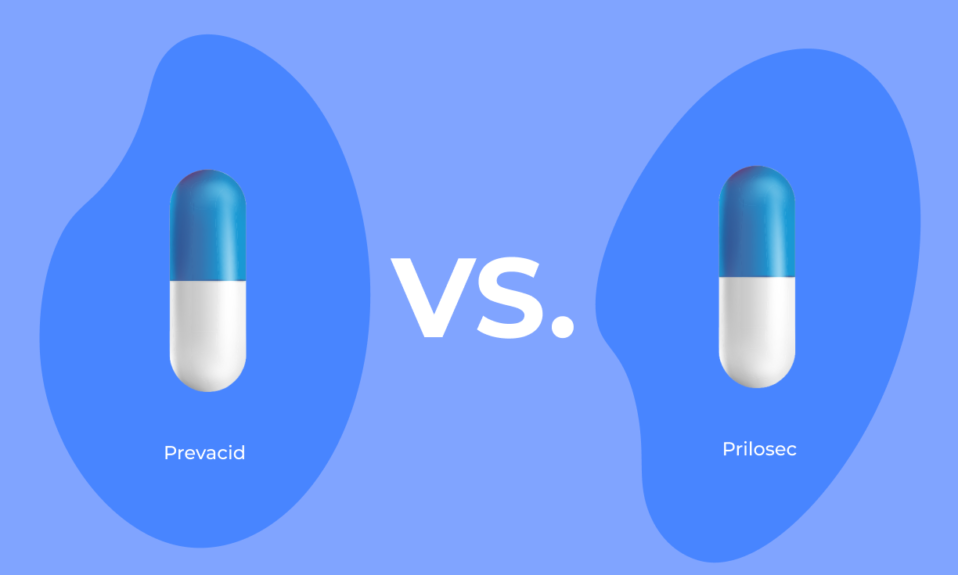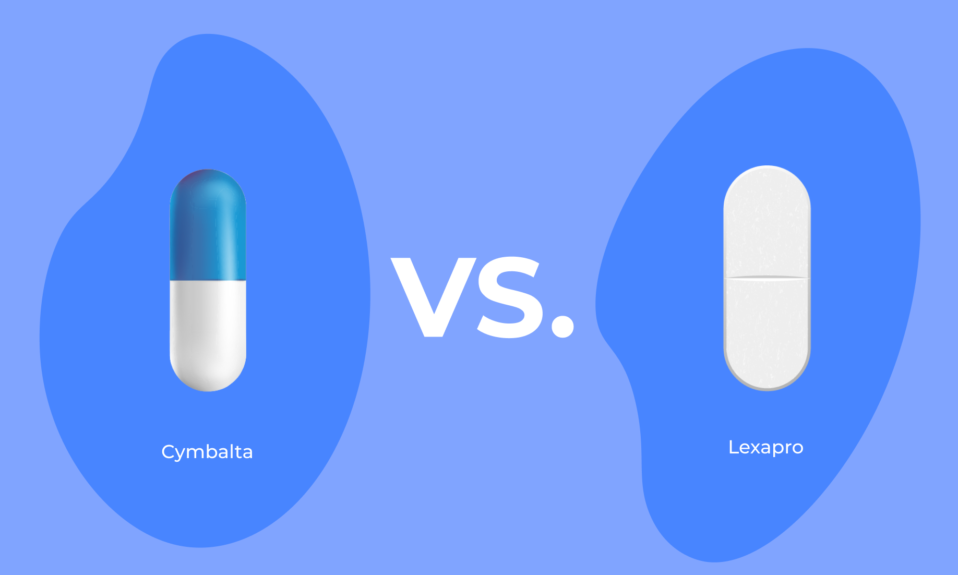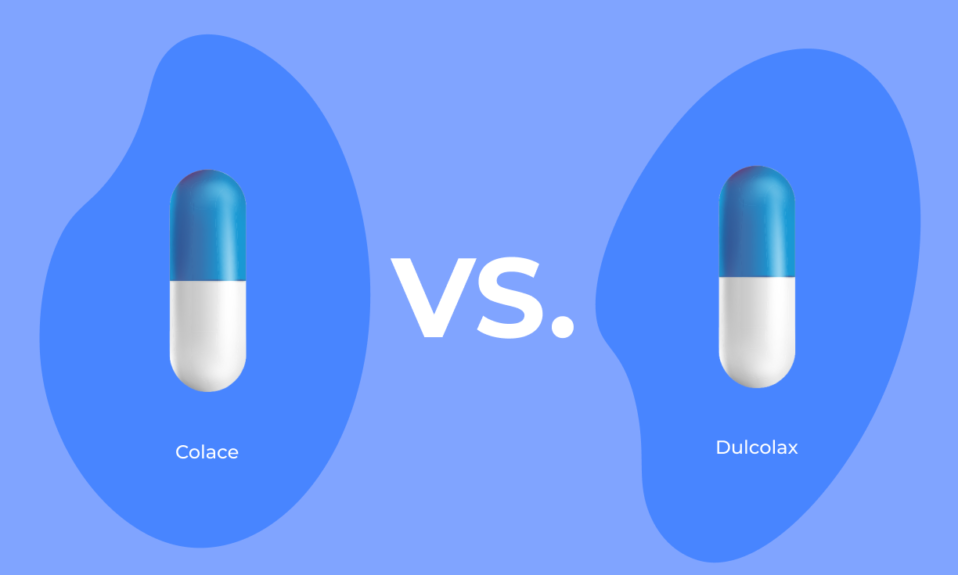Table of Contents Hide
Gastrointestinal conditions are often treated with proton pump inhibitors. This article will review Prevacid vs. Prilosec in clinical outcomes, interactions, and side effects.
Proton Pump Inhibitors and Gastrointestinal Disorders
Proton pump inhibitors work by reducing or even blocking stomach acid production, hence reducing or eliminating heartburn – a common symptom in many gastrointestinal conditions, including gastroesophageal reflux disease (GERD) and stomach ulcers.
Prevacid (Lansoprazole) and Prilosec (Omeprazole) are two proton pump inhibitors (PPIs) prescribed for gastrointestinal conditions associated with heartburn. The two medications are similar but not identical in therapeutical indications and side effects. For this reason, prescribing one or the other is informed by an evaluation of the patient’s health condition, current treatment, and age.
Prevacid vs. Prilosec: Key Similarities and Differences
Some conditions associated with heartburn are only managed with Prevacid, while others are only addressed with Prilosec. For instance, Prevacid is indicated for stomach ulcers, intestinal ulcers, GERD, helicobacter pylori infection, Zollinger-Ellison syndrome, Barrett’s esophagus, erosive esophagitis, and heartburn and stomach ulcer prevention.
Prilosec indications include reduction of excessive stomach acid, stomach ulcer, duodenal ulcer disease, erosive esophagitis, GERD, helicobacter pylori infection, prevention of stress ulcers in critically ill patients, and prevention or treatment of stomach ulcers produced by a nonsteroidal anti-inflammatory drug (NSAID).
Both Prilosec and Prevacid last longer than other acid reducers such as Zantac, Tums, or Pepcid. Prilosec needs to be taken once or twice daily while Prevacid is given once daily. Unlike quick-acting antacids like Maalox or Tums, Prevacid does not work immediately. For immediate relief, one can take Prevacid or Prilosec along with a quick-acting antacid.
Those who have difficulties swallowing pills have the option to take Prevacid dissolving tablets or consider the drug’s liquid version. Prilosec, on the other hand, can be taken in pill and powder forms. Both Prevacid and Prilosec offer generic and over-the-counter options.
Prevacid and Prilosec interact with some antiretrovirals, blood thinners such as Coumadin (warfarin), Lanoxin (digoxin), rifampin, and St. John’s Wort, among others. Some drugs only interact with Prevacid or with Prilosec, the reason for which it is essential to inform your health care provider about your full medication scheme.
| Differences between Prilosec and Prevacid | ||
| Prilosec | Prevacid | |
| Proton Pump Inhibitor | Drug Class | Proton Pump Inhibitor |
| Yes, Omeprazole | Comes in Generic form? | Yes, Lansoprazole |
| Varies by indication: usually 20-40 mg once or twice daily | Standard Dosage? | Varies by indication: usually 15-30 mg once or twice daily |
| Rx: delayed-release capsules, suspension OTC: delayed-release tablets | Different forms? | Rx: delayed-release capsules, soluble tablets OTC: delayed-release capsules |
| 10 days to 8 weeks, many patients take longer | How long is the typical treatment? | 10 days to 12 weeks, many patients take longer |
| Adults; children 2 years and older | Who can use the medication? | Adults; children 1 year and older |
Find the best price on Prilosec, up to 90% off
Prevacid and Prilosec Appear to be Roughly Equal in Terms of Safety and Efficacy
A potential side effect of Prevacid is the risk of C. diff infection. Prevacid can also lead to abdominal pain, diarrhea, constipation, headache, and nausea.
Side effects following Prilosec use include abdominal pain, headache, flatulence, nausea, diarrhea, and vomiting. Potential side-effects from long-term Prilosec use include low magnesium and B12 levels, rebound acid section, and osteoporosis.
Prevacid and Prilosec may interfere with the body’s ability to absorb calcium, accelerating bone loss and leading to an increased number of fractures. For this reason, treating older patients with these drugs requires additional safety considerations.
A meta-analysis of 57 studies exploring the efficacy of different proton pump inhibitors found that, milligram for milligram, Prevacid was relatively less efficient in reducing gastric acid compared to Prilosec. On the other hand, an older meta-analysis suggested that there are no significant differences between these drugs in terms of efficacy and safety and that dose was the best predictor of clinical outcome.
One study with 40 participants comparing the two drugs in terms of efficacy in reducing heartburn relief found that patients treated with 20.6 mg of Prilosec showed a higher level of gastric acid suppression as assessed by a 24-h gastric pH monitoring compared to those treated with 15 mg of Prevacid.
This study did not include individuals older than 65 years or with a history of gastrointestinal disease other than frequent heartburn. For this reason, it remains to be determined whether similar results will be obtained with a more diverse sample in age and gastrointestinal disorders.
Find the best price on Prilosec, delivered free
Takeaway
Prevacid and Prilosec are two safe and effective proton pump inhibitors that can be used to treat or manage a variety of gastrointestinal conditions. Each of the two drugs comes with advantages and inconveniences when compared to the other.
Based on some studies, Prilosec appears to be slightly more effective in reducing stomach acid compared to Prevacid. Other studies, however, find no significant difference in efficacy between the many types of proton inhibitors available. This contradiction in data may imply that differences if they exist, are not particularly relevant.
In terms of safety, the two proton inhibitors are comparable, with side effects not being very common. People older than 65 have a higher risk of bone fractures following long-term Prevacid and Prilosec use. Proton pump inhibitors may interfere with the body’s ability to absorb calcium, accelerating bone loss and leading to an increased number of fractures.
Choosing between Prevacid and Prilosec does not appear to be a question of choosing the better drug between two alternatives. As is the case with other treatments, the selection of a proton inhibitor at a given dose should be informed by your medical history, current medication, and age.
FAQ
Does Prevacid (Lansoprazole) have fewer side effects than Prilosec (Omeprazole)?
Lansoprazole and omeprazole are comparable in terms of safety and efficacy. Each drug comes with specific side-effects risks that should be considered before treatment initiation.
Do all proton pump inhibitors have the same side effects?
Proton pump inhibitors have similar but not identical side effects.
What does Prilosec interact with?
Prilosec interacts with some antiretrovirals, blood thinners such as Coumadin (warfarin), Lanoxin (digoxin), rifampin, and St. John’s Wort, among others.
Which one is better Prevacid or Prilosec?
There is no universal answer to this question. The selection of a proton inhibitor at a given dose should be informed by your medical history, current medication, and age.
Which is stronger Prilosec or Prevacid?
Omeprazole appears to be slightly more effective than lansoprazole in reducing stomach acid; nevertheless, the strength of the effect largely depends on the dose of the drug and not on the drug itself.
Why should you not take Prilosec?
Prilosec interacts with several types of medication and has specific side effects that should be considered before treatment.
Sources
Klok, R. M., Postma, M. J., Van Hout, B. A., & Brouwers, J. R. B. J. (2003). Meta‐analysis: comparing the efficacy of proton pump inhibitors in short‐term use. Alimentary pharmacology & therapeutics, 17(10), 1237-1245.
Kirchheiner, J., Glatt, S., Fuhr, U., Klotz, U., Meineke, I., Seufferlein, T., & Brockmöller, J. (2009). Relative potency of proton-pump inhibitors—comparison of effects on intragastric pH. Eur J Clin Pharmacol, 65, 19-31.
Miner Jr, P. B., McKean, L. A., Gibb, R. D., Erasala, G. N., Ramsey, D. L., & McRorie, J. W. (2010). Omeprazole‐Mg 20.6 mg is superior to lansoprazole 15 mg for control of gastric acid: a comparison of over‐the‐counter doses of proton pump inhibitors. Alimentary pharmacology & therapeutics, 31(8), 846-851.
Roman, S., & Kahrilas, P. J. (2013). Overview of gastroesophageal reflux disease treatments. Practical Manual of Gastroesophageal Reflux Disease, 53.
Savarino, V., Dulbecco, P., de Bortoli, N., Ottonello, A., & Savarino, E. (2016). The appropriate use of proton pump inhibitors (PPIs): Need for a reappraisal.










